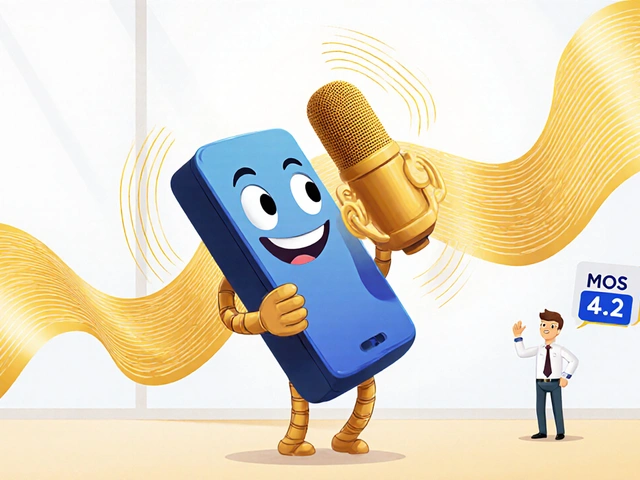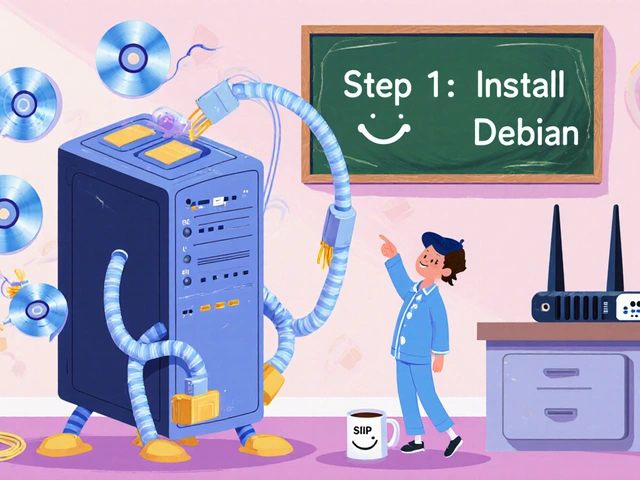Why Your Customers Are Talking Across Channels - And Why You Need to Track It All
Imagine this: a customer tweets a complaint about a late delivery. You respond on Twitter, but they don’t reply. Two hours later, they call your support line - and start from scratch. They repeat their order number, explain the delay again, and get frustrated when you can’t see their earlier message. This isn’t rare. It’s the norm for companies still using disconnected tools. VoIP and social media integration fixes this by turning scattered conversations into one clear story.
Today, customers don’t care if they started on Instagram, moved to WhatsApp, then called your line. They just want their issue solved - fast. And if you’re not tracking every step, you’re losing trust, wasting time, and leaving money on the table. According to eClincher’s 2023 data, businesses using integrated VoIP and social media systems cut average resolution time by 37%. That’s not a guess. That’s real numbers from real companies.
How VoIP and Social Media Work Together
VoIP isn’t just about making phone calls over the internet. It’s a platform that can connect with Facebook Messenger, WhatsApp Business, Instagram DMs, LinkedIn, and Twitter - all from one dashboard. When a customer messages you on Instagram, that interaction gets saved in their profile. If they later call, your agent sees the full history: what they said, when they said it, even what they bought last month.
This works because modern systems use WebRTC for voice and API connections for social platforms. JivoChat, for example, syncs data in under 1.2 seconds. Nextiva and 8x8 do the same. No more switching between tabs. No more asking customers to repeat themselves. The system does the work.
Behind the scenes, everything is encrypted. Voice calls use SRTP. Data in transit moves over TLS 1.3. Stored messages are locked with AES-256 encryption - the same standard banks use. OnSIP’s 2023 audit by Trustwave confirmed these protections are solid. You’re not just connecting channels - you’re securing them.
The Real Benefits: Faster Resolutions, Happier Customers
Companies using integrated systems don’t just save time - they change how customers feel about them. A Shopify merchant in Wisconsin saw customer satisfaction scores jump 27% after linking their VoIP system to social media. Why? Because customers felt heard.
Here’s how it breaks down:
- First-contact resolution increased by 28% - agents had all the info upfront, so they solved issues on the first try.
- Resolution time dropped from 48 hours to under 4 hours - one e-commerce manager on Trustpilot shared this exact result.
- Data fragmentation fell by 63% - no more scattered notes, spreadsheets, or forgotten chats.
Dr. Emily Chen from Harvard Business School calls this the biggest leap in customer experience since CRM systems first appeared. And she’s right. When you can see that a customer tweeted a complaint, then called, then opened a support ticket - you’re not just handling tickets. You’re managing relationships.
What You Can Integrate - And What You Can’t
Not all platforms play nice. Most systems support Facebook Messenger, WhatsApp Business, and LinkedIn Messaging without issue. Twitter DMs and Instagram Direct are trickier. Facebook limits access to 24 hours of chat history unless you’re an approved business partner. Instagram’s API is even more restricted - you can’t pull past messages or media without special permissions.
That’s why smart companies focus on the platforms their customers actually use. If your audience is on WhatsApp, prioritize that. If your B2B clients use LinkedIn, make sure that’s integrated. Don’t waste time forcing Instagram if your customers aren’t there.
But it’s not just social media. These systems also connect to:
- CRMs: Salesforce, HubSpot, Agile CRM
- Helpdesks: Zendesk, Freshdesk
- Analytics: Google Analytics 4, Tableau
Nextiva’s API alone supports 87 integrations. That means you can tie call data to marketing campaigns, track which social posts lead to sales, and see which agents close the most deals. This isn’t just support - it’s business intelligence.
Top Platforms Compared: What’s Best for You?
Not all systems are built the same. Here’s how the leaders stack up as of April 2024:
| Platform | Price per User/Month | Key Strengths | Limitations |
|---|---|---|---|
| RingCentral | $39.99 | Most features, best AI tools, seamless CRM sync | Expensive for small teams, overkill if you only need basics |
| Nextiva | $49.99 | Best social media tracking, 4.5/5 user rating, fastest support (0.7 hrs) | Pricier than competitors, setup can be complex |
| 8x8 | $24.00 | Best value for SMBs, excellent documentation, strong compliance tools | Fewer AI features than RingCentral |
| JivoChat | $29.99 | Best for e-commerce, real-time sentiment analysis, easy setup | Smaller support team, fewer enterprise features |
If you’re a small business with 10 agents, 8x8 gives you 90% of the power at half the price. If you’re a mid-sized company with 100+ agents and heavy social media traffic, Nextiva’s detailed tracking and support make it worth the cost. RingCentral leads in AI and analytics - but only if you need them.
Implementation: What to Expect (and How to Avoid Pitfalls)
Setting this up isn’t plug-and-play. Capsule CRM’s 2024 guide says most companies need 8-10 weeks. Here’s the real process:
- Discovery (2-3 weeks): Map out which channels your customers use. List your current tools. Identify data gaps.
- Configuration (3-4 weeks): Connect APIs, map fields between CRM and social platforms, set up user roles.
- Testing (2 weeks): Simulate customer journeys. Did the tweet turn into a call? Did the agent see the history?
- Rollout (1-2 weeks): Train your team. Start with one department. Expand slowly.
Common mistakes?
- Skipping consent workflows - GDPR and FCC require you to notify customers when calls are recorded. Many companies get fined for not doing this.
- Ignoring API limits - Facebook allows only 200 calls/hour per page. If you get 500 messages in a day, your system will stall unless you build in queuing.
- Assuming your team can handle it - Agile CRM says you need at least one person who understands OAuth 2.0 and JSON/XML. If you don’t have that, hire a consultant.
Support matters too. Nextiva answers questions in under an hour. Smaller vendors take 3-5 hours. If your system goes down during peak hours, that delay costs you sales.
The Future: AI, Compliance, and the End of Silos
What’s next? The tools are getting smarter. JivoChat’s April 2024 update automatically flags frustrated customers from social messages and pushes them to the top of the call queue. If someone types “I’m so mad,” the system alerts an agent to call them within 5 minutes.
Nextiva’s “Social Voice Sync” (launched May 2024) links a caller’s phone number to their social profiles - even if they didn’t mention them. That’s powerful. Imagine knowing that the person on the line is the same one who posted a negative review yesterday - without them saying a word.
By 2025, AI will summarize every interaction. Instead of reading 12 messages and a 10-minute call transcript, your agent gets a one-line summary: “Customer tweeted complaint about delivery delay on 10/25. Called today. Order #12345. Previously contacted via WhatsApp. No prior complaints.”
And compliance? It’s getting stricter. The EU’s GDPR and U.S. FCC rules are tightening. Systems now auto-generate consent pop-ups before recording calls. If you’re selling to customers in multiple countries, your tool must handle that - or you risk fines.
Is This Right for Your Business?
If you answer “yes” to any of these, you need VoIP and social media integration:
- Do customers contact you on more than one channel?
- Do agents often say, “I’ve seen this before - where’s the history?”
- Are you losing sales because customers give up after repeating themselves?
- Do you track social media complaints but can’t link them to phone calls?
If you’re a small business with 5-20 agents and limited tech resources, start with 8x8 or JivoChat. They’re affordable, simple, and get the job done. If you’re a growing company with 50+ agents and heavy social media traffic, Nextiva or RingCentral will give you the depth you need.
This isn’t a nice-to-have anymore. It’s the baseline. Customers expect seamless service. If you’re still treating social media and phone calls as separate worlds, you’re already behind.
Can VoIP and social media integration work for small businesses?
Yes - and it’s often more valuable for small businesses than large ones. With fewer resources, every interaction counts. Platforms like 8x8 and JivoChat start at under $25/user/month and offer simple setup. A small e-commerce shop can use this to turn a single tweet into a resolved sale without hiring extra staff.
Do I need to record all calls?
No - but you must ask for consent if you do. In the U.S., FCC rules require you to notify callers that the conversation may be recorded. In the EU, GDPR demands explicit opt-in. Most platforms now include automated consent prompts, but you still need to configure them correctly. Never record without permission.
What happens if Facebook changes its API?
Facebook changes its API about 3 times per quarter, and that breaks integrations. Good platforms monitor these changes and push updates automatically. Nextiva and 8x8 have dedicated teams for this. Avoid providers who don’t mention API maintenance - you’ll be stuck with broken connections.
Can I use this with my existing CRM?
Almost certainly. Most VoIP-social media platforms connect to Salesforce, HubSpot, Zendesk, and others. Check the vendor’s integration list before buying. If your CRM isn’t listed, ask if they offer custom API setup - many will do it for a fee.
How long does it take to see results?
Most companies see faster resolution times within 2-4 weeks of rollout. Customer satisfaction scores usually rise after 6-8 weeks as agents get comfortable using the system. The biggest gains come from reducing repeat contacts - that’s the metric to watch first.
Is this secure?
Yes, if you choose a reputable provider. Top platforms use end-to-end encryption for calls (SRTP), TLS 1.3 for data transfer, and AES-256 for stored data. Third-party audits by Trustwave and others confirm this. Avoid cheap tools that don’t mention security - your customer data isn’t worth risking.








Michael Thomas
29 Oct 2025 at 22:27This is why America still leads in customer service tech. Other countries are still stuck in the 2010s with email tickets and call centers that don't talk to each other. VoIP + social integration isn't optional-it's national infrastructure now.
And no, 'small business' doesn't mean you get a pass. If you're not tracking every touchpoint, you're just wasting time and money.